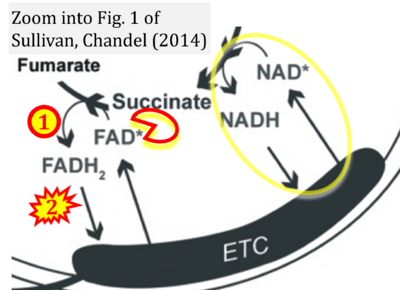Sullivan 2014 Cell Cycle
| Sullivan LB, Chandel NS. (2014) Mitochondrial metabolism in TCA cycle mutant cancer cells. Cell Cycle 13:347-8. https://doi.org/10.4161/cc.27513 |
Sullivan LB, Chandel NS. (2014) Cell Cycle
Abstract: Normal cells and cancer cells rely on mitochondria for a range of essential functions including production of ATP, biosynthetic intermediates, heme and iron-sulfur clusters, and reactive oxygen species (ROS) for signaling. These functions are essential for cell survival and proliferation. Most cancer cells have functional mitochondria to fulfill these essential requirements; however, there is a subset of cancers which derive from a loss of function in tricarboxylic acid (TCA) cycle enzymes, including fumarate hydratase (FH).1 Cancer cells with loss of FH function are respiratory-deficient and accumulate high levels of fumarate. This raises an intriguing question: how do cancer cells with dysfunctional mitochondria fulfill their requirements for cell proliferation?
• Bioblast editor: Gnaiger E
Correction: FADH2 and Complex II
- FADH2 is shown as the substrate feeding electrons into Complex II (CII). This is wrong and requires correction - for details see Gnaiger (2024).
- Gnaiger E (2024) Complex II ambiguities ― FADH2 in the electron transfer system. J Biol Chem 300:105470. https://doi.org/10.1016/j.jbc.2023.105470 - »Bioblast link«
Labels:
Pathology: Cancer


